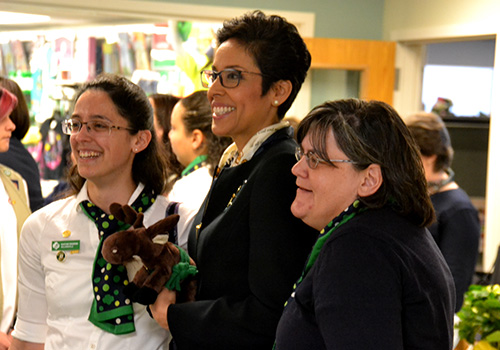National Girl Scout CEO says organization training future leaders, entrepreneurs

Photos by Tom Rivers – Anna Maria Chavez, CEO of the Girl Scouts of USA, meets with Girl Scouts, volunteers and staff last week at the office in Rochester for Girls Scouts of Western New York. There are 161 Girl Scouts in Orleans County and 37 volunteers.
ROCHESTER – Anna Maria Chavez, CEO of the Girl Scouts of USA, visited the Rochester and Buffalo region late last week to visit Scouts, volunteers and staff with the Girl Scouts of Western New York, which serves nine counties in WNY, including about 16,000 girls and 7,000 adults.
Chavez has served as national CEO of the organization since 2011. She grew up as a Girl Scout in Eloy, Arizona. In 2016, she was named as one of the World’s 50 Greatest Leaders by Fortune magazine, which cited for her vision and creativity in working to revitalize the Girl Scout brand for a new century, including debuting new badges in STEM and financial literacy, and initiatives like Digital Cookie, the first national digital platform for the iconic Girl Scout Cookie Program.
She sat down for an interview April 28 at the Girl Scouts service center in Rochester on Elmwood Avenue, down the street from Mount Hope Cemetery, where women’s rights leader Susan B. Anthony is buried.
Question: Is the Rochester area on the national radar for the Girl Scouts because we’re home to Susan B. Anthony, Elizabeth Cady Stanton, Harriett Tubman and other prominent women?
Answer: Absolutely.
As you know Harriett Tubman was just announced to be on the $20 bill. We were behind and one of the big proponents of getting women on the currency.
We’re all about telling the story what our organization has done. Our founder was organizing opportunities for girls long before women had the right to vote.

Harriett Tubman, whose home is in Auburn, will be the new face of the $20 bill.
As the suffragette movement was taking off, she was in Savannah, Ga., developing a global organization for girls. (Editor’s Note: Juliette Gordon Low founded the Girl Scouts in 1912 in Savannah, Ga.)
Question: When you say Girl Scouts were advocating for women on currency, what were Scouts doing?
Answer: At first 40,000 Girl Scouts reached out and basically wrote to advocate on behalf of our founder that she be considered as one of the individuals on the currency. But the larger message was it’s time to show that women have played a significant role in this country’s history and impact, and what better way to here directly from girls.
I just spoke to the Treasurer of the United States, Rosa Rios, and she has been one advocating for this for several years. They are going to start with the $10 bill and the $20 bill, and the focus is both on the back sides of the currency and to have someone on the front side.
Harriett Tubman is a prime candidate for that. (Editor’s Note: Tubman will replace Andrew Jackson on the $20, and Alexander Hamilton will stay on the $10.)
The larger discussion continues around how else can we memorialize the amazing impact of women and girls in this country. It’s a continuous conversation we are having.
Question: People might wonder how the Girl Scouts, now in their 104th year, are changing because I think there are perceptions it might be a baking club. I know from my son being in the Lego group in Albion that the Hippie Pandas (a Girl Scout team in Rochester) is a dominant team, beating the boys. They are a major STEM program.
Answer: The Girl Scouts are more relevant than ever. We are looking for opportunities to share that story. We’ve been in every zip code in the country for a hundred years. We’ve been part of our communities.
The story is we are based on very concrete values around service, around empowering girls to be self reliant, to serve others and most importantly to prepare for leadership at the age of 12 and the age of 20.

Emma Wadhams, an Albion Girl Scout, carries the American flag while leading Scouts down East Avenue in the Memorial Day parade in Albion last May.
So we talk about our history but we also talk about how we are relevant today. I’ll give you a couple of examples. One of the biggest issues facing the economy right now is a strong workforce in particular based on STEM. We run the largest empowerment program for girls in the world. People don’t know that.
We also run the largest entrepreneurial program for girls in the world: It’s the cookie program. You talk to all of the major CEOs who were Girl Scouts, and I can name them all for you, and they will tell you they started their business acumen by selling Girl Scout cookies – 8-year-old girls doing cold calls. How to take no and still persevere. What is her delivery model? How is she going to invest her revenue? We have now the ability to take girls from that platform. We have digitized it for the first time in a hundred years.
I love the stories that I hear where they are taking that cookie revenue and investing it in non-profits. They are funding your local animal shelters, your congregate meal sites, your senior centers, your local parks. That is the story we want to tell.
When you invest in a local Girl Scout, you’re actually investing in your local community. Our data shows that our girls are definitely more resilient. If you look at our alum, when you look at their path – and we have 59 million living alumni – and they are doing amazing things. They are making more money than non-Girl Scouts, $12,000 more a year. They are bringing back more resources to their families. They are much more culturally, community and civically engaged. We even looked at our Girl Scout mothers and they volunteer more in their kids’ schools than our non-alums.
Girl Scouts also go on to get higher levels of education. They go on to not only get their BA’s, but their JD’s, their MBAs, their PHDs, and they are voting. They are very actively involved in the economic and political systems, both regionally and nationally.
And, when you ask them about their life choices, the decisions they’ve made in their own life whether family, career, or their own opportunities, they are happy. They have made decisions that resonate with their values and they see the impact they are making.

Anna Maria Chavez, CEO of the Girl Scouts of USA, is pictured with Susan Cook, a former Albion resident and Orleans Hub reporter who is now a community relations specialist for the Girl Scouts.
For $15 a year investment in membership, this is what a girl can get. For the local community it costs about $300 a year to serve a girl and that’s why we really have to talk to our community members about investing in our local council to ensure that they can reach all girls.
Question: What are some of the challenges – maybe money and having enough dedicated adult volunteers?
Answer: What we have found over the years is it is taking more for families to succeed in life. Parents are having to work. Our model was built where someone could stay at home 100 percent of the time. That is no longer the case. You have grandparents raising grandkids. You have single-parent households. We had to reformate our sort of infrastructure in the field to support all types of volunteers.
There are episodic volunteer opportunities or there are troop leaders who are going to be with girls consistently year to year. We’re doing that through technology.
Question: STEM sounds like a great thing, but is it harder to find volunteers to lead those more technical programs?
Answer: The other thing is we’re trying to talk to the men. You may think it’s only for female volunteers. But the reality is our research has shown – and we have our own Girl Scout research here in New York – that 75 percent of girls love STEM. They resonate to math and science, and they’re really good at it. But they stop taking those courses because they’re getting different messages from their peers, from their teachers and from the community that STEM is not for girls to do.
The number one factor for girls whether they continue their STEM education and go into a STEM career is the male figure in her household. The father, the uncle who is mentoring her, who is taking her to the local lab – girls are looking for those mentorship opportunities from both women and also from men in the field.
Question: Why are you here visiting Rochester and Buffalo?

The Hippie Pandas, a team from a Girl Scout troop in Churchville, was the overall champion in a FIRST Lego League competition in November 2014 in Churchville. The Hippie Pandas also designed the best robot. They advanced to the national event in 2013.
Answer: I’m so excited to be her. First of all this council has done amazing things for many, many years. They are also a great example of how we are really re-energizing and looking at using technology to almost bring a new renaissance to Girl Scouts in this area. They are combining the great DNA that we have around outdoors – because we know that girls need to be outdoors, they need to be out there exercising and out in the wilderness without a cell phone to connect with nature – but they also need to understand there are other opportunities for them to get ready to exceed in school and also to excel in soft skills that we consider very important in the workforce: how to work on teams, how to collaborate, how to express your opinion in a group environment. So this team (The Girl Scouts of Western New York) has done an amazing job creating local Girl Scout programming and also embracing our national Girl Scout leadership experience that is focused on getting girls outdoors and other leadership opportunities.
Question: Is this a fire-up-the-troops visit?
Answer: I work for the field. The average age of my boss is 8 years old. So for me it’s getting out and listening to our girls, to our volunteers, and supporting our amazing local leadership and staff, and also to talk to community members about the importance of investing in girls.
Today with all of the billions of dollars that are donated in the philanthropic area only 7 percent go to women and girl causes. Think about that, only 7 percent. So we clearly need to tell the story why it is so important to invest in women and girls.
We are the pipeline. We are the largest prevention program in the world. We are helping girls to see their potential to build resiliency, to really think through their life so when they are met with other choices at 12 and 13 years old they are picking the right path for a brighter future and opportunity.
In addition, we are serving girls across the country who may not have opportunities due to a financial situation. We are serving girls in foster care. We actually have a program where we take troop meetings behind bars where mothers are incarcerated. We have troop meetings in prisons. Our data shows we have cut down the recidivism rate for that family. We have allowed those mothers who are incarcerated to continue to have that bonding with their daughter.
We are opening the eyes of people around the country who may think of Girl Scouts in a certain way. The fact is we’re multidimensional, we’re in 90 countries in the world and it’s a girl-led organization.






































































